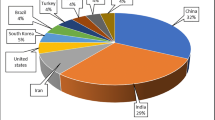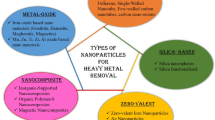Abstract
Wastewater from the uranium mining industry contains toxic arsenate (AsO43–), selenate (SeO42–), and molybdate (MoO42–) that can be removed by complexation with MgAlFe(III)CO3SO4 hydrotalcites, yet underlying mechanisms are poorly known. Here, we studied complexation by K–edge Extended X-ray Absorption Fine Structure Spectroscopy, Density Functional Theory, Powder X-ray Diffraction, and Infrared and Raman Spectroscopy. We found that single shell paths with a coordination number of 4 and bond lengths of As–O = 1.69 Å, Se–O = 1.65 Å and Mo–O = 1.76 Å were best fitted for As–MgAlFe, Se–MgAlFe, and Mo–MgAlFe hydrotalcites. We observed a single antisymmetric υ3 band with no splitting at 821 cm−1 for AsO43–, 856 cm−1 for SeO42–, and 852 cm−1 for MoO42–. In all cases, basal (d003) and interlayer (d006) spacings before and after anion adsorption varied by less than 0.1 Å. Therefore, our findings demonstrate that arsenate, selenate, molybdate form outer-sphere-like complexes with MgAlFe hydrotalcite, and that these complexes are surface-bound and not intercalated.


Similar content being viewed by others
References
Belloto M, Rebours B, Clause O, Lynch J, Bazin D, Elkaim E (1996) A re-examination of hydrotalcite crystal chemistry. J Phys Chem 100:8527–8534
Burke IT, Peacock CL, Lockwood CL, Stewart DI, Mortimer RJG, Ward MB, Renforth P, Gruiz K, Mayes WM (2013) Behaviour of aluminon, arsenic and vanadium during the neutralization of red mud leachate by HCl, gypsum or seawater. Environ Sci Technol 47:6527–6535
Cavani F, Trifiro F, Vaccari A (1991) HT-type anionic clays: preparation, properties, and applications. Catal Today 11:173–301
Dinis ML, Fiuza A (2021) Mitigation of uranium mining impacts-a review on groundwater remediation technologies. Geosciences 11(6):250
Douglas GB (2015) Treatment or remediation of natural or wastewater. US Patent. US 9133038B2
Dzombak DA, Morel FMM (1990) Surface complexation modeling. John Wiley and Sons, New York
Foster AL, Kim CB (2014) Arsenic speciation in solids using X-ray absorption spectroscopy. Rev Mineral Geochem 79:257–369
Goh KH, Lim TT, Dong Z (2008) Application of layered double hydroxides for the removal of oxyanions: a review. Water Res 42:1343–1368
Gomez MA, Hendry MJ, Koshinsky J, Essilfie-Dughan J, Paikaray S, Chen J (2013) Mineralogical controls on aluminum and magnesium in uranium mill tailings: key lake, Saskatchewan, Canada. Environ Sci Technol 47:7883–7891
IAEA (2004) Treatment of liquid effluents from uranium mines and mills. IAEA TECDOC No.1419.https://www-pub.iaea.org/mtcd/publications/pdf/te_1419_web.pdf. Accessed 3 Mar 2023
Kloprogge JT, Wood BJ (2017) X-ray photoelectron spectroscopic and Raman microscopic investigation of the variscite group minerals: variscite, strengite, scorodite and mansfieldite. Spectrochim Acta Part A 185:163–172
Masue Y, Loeppert RH, Kramer TA (2006) Arsenate and arsenite adsorption and desorption behaviour on coprecipitated aluminum: iron hydroxides. Environ Sci Technol 41(3):837–842
O’Hara P, Cox J, Robson D M, Mathisen M (2018) Arrow deposit, rook I project. NI 43–101 technical report on pre-feasibility study. https://www.nexgenenergy.ca/rook-1-project/. Accessed 5 Mar 2023
Opiso EM, Sato T, Morimoto K, Asai A, Anraku S, Numaku C, Yoneda T (2010) Incorporation of arsenic minerals during the formation of Mg-bearing minerals at alkaline conditions. Miner Eng 23:230–237
Opiso EM, Sato T, Yoneda T (2016) Immobilization of selenium by Mg-bearing minerals and its implications for selenium removal from contaminated water and wastewater. Appl Clay Sci 123:121–128
Paikaray S, Hendry MJ, Essilfie-Dughan J (2013) Controls on arsenate, molybdate and selenate uptake by hydrotalcite-like layered double hydroxides. Chem Geol 345:130–138
Palmer SJ, Soisonard A, Frost RL (2009) Determination of the mechanism(s) for the inclusion of arsenate, vanadate or molybdate anions into hydrotalcites with variable cationic ratios. J Colloid Interface Sci 329:404–409
Robertson J, Essilfie-Dughan J, Lin J, Hendry MJ (2017) Coordination of arsenic and nickel to aluminum and magnesium phases in uranium mill raffinate precipitates. Appl Geochem 81:12–22
Robertson J, Hendry MJ, Kotzer T, Hughes KA (2019) Geochemistry of uranium mill tailings in the Athabasca Basin, Saskatchewan, Canada: a review. Crit Rev Environ Sci Technol 49(14):1237–1293
Su C, Suarez DL (2000) Selenate and Selenite sorption on iron oxides: an infrared and electrophoretic study. Soil Sci Soc Am J 64:101–111
Theiss FL, Couperthwaite SJ, Ayoko GA, Frost RL (2014) A review of the removal of anions and oxyanions of the halogen elements from aqueous solution by layered double hydroxides. J Colloid Interf Sci 417:356–368
Wang J, Zhang TQ, Li M, Yang Y, Lu P, Ning P, Wang Q (2018) Arsenic removal from water/wastewater using layered double hydroxide derived adsorbents, a critical review. Rsc Adv 8:22694–22709
Staff Writers (2016) Virtual curtain draws Chinese interest. In TechInvest. https://techinvest.online/virtual-curtain-draws-chinese-interest/. Accessed 5 Mar 2023
Wu X, Tan X, Yang S, Wen T, Guo H, Wang X, Xu A (2013) Coexistence of adsorption and coagulation processes of both arsenate and NOM from contaminated groundwater by nanocrystallined Mg/Al layered double hydroxides. Water Res 47:4159–4168
Acknowledgements
We like to thank Prof. Yongfeng Jia at the Institute of Applied Ecology for the use of Raman and ATR-FTIR instruments.
Funding
Funding for this work was provided by the National Natural Science Foundation of China (No. 41703129, 42207258, and 52270150) and the Elettra synchrotron (proposal 20187130).
Author information
Authors and Affiliations
Corresponding author
Ethics declarations
Conflicts of Interest
There are no conflicts of interest to declare.
Additional information
Publisher's Note
Springer Nature remains neutral with regard to jurisdictional claims in published maps and institutional affiliations.
Supplementary Information
Below is the link to the electronic supplementary material.
Rights and permissions
Springer Nature or its licensor (e.g. a society or other partner) holds exclusive rights to this article under a publishing agreement with the author(s) or other rightsholder(s); author self-archiving of the accepted manuscript version of this article is solely governed by the terms of such publishing agreement and applicable law.
About this article
Cite this article
Gomez, M.A., Ma, X., Chen, Y. et al. Mechanism of complexation of toxic arsenate, selenate, and molybdate with hydrotalcites. Environ Chem Lett 21, 2519–2523 (2023). https://doi.org/10.1007/s10311-023-01597-z
Received:
Accepted:
Published:
Issue Date:
DOI: https://doi.org/10.1007/s10311-023-01597-z




